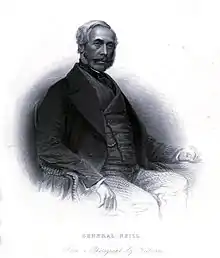Neil Statue Satyagraha
Neill statue Satyagraha was an agitation that took place in Madras Presidency, British India during the Indian Independence Movement. It took place in 1927 demanding the removal of the statue of Colonel James Neill situated at Mount Road (now Anna Salai) in Madras.


James Neill of the Madras Fusileers regiment played a major role in putting down the Indian Rebellion of 1857. He was killed during the siege of Lucknow and was reviled as the "Butcher of Allahabad" by the Indians. A statue of him was placed at Mount Road, Madras. In 1927, it became the target of the Indian nationalists. The Madras Mahajana Sabha and the Madras provincial committee of the Indian National Congress passed a resolution demanding its removal. They started a series of demonstrations in Madras. The agitators came from all over the Madras Presidency and were led by S. N. Somayajulu of Tirunelveli. Several agitators were arrested and sentenced to prison terms ranging from a few weeks to a year of rigorous imprisonment. After the major leaders - Somayajulu and Swaminatha Mudaliar were arrested, K. Kamaraj became the leader of the agitation (September 1927). Mahatma Gandhi who visited Madras during the same time, gave his support to the agitation. The Madras legislature also passed resolutions demanding the removal of the statue. The agitation lost steam after a few months and was dropped to make way for the Simon Commission boycott.[1][2][3]
Neill's statue remained in the same place and was moved to the Ripon Building campus for a few years. In 1937, when the newly elected Congress government (under the 1935 act) of C. Rajagopalachari moved it to the Madras museum after a resolution demanding its removal was passed in the Madras Corporation. As of 2021, it still remains in the Anthropology section of the museum.[1][4]
References
- Venkatesh, M. R. "The 'Butcher of Allahabad' lies in a museum attic". Deccan Herald. Retrieved 6 October 2011.
- The Political Career of K. Kamaraj. Concept Publishing Company. p. 31.
- Iyengar, A. S (2001). [Role of press and Indian freedom struggle: all through the Gandhian era Role of press and Indian freedom struggle: all through the Gandhian era]. APH Publishing. p. 266. ISBN 978-81-7648-256-1.
{{cite book}}: Check|url=value (help) - "The Impact Of The 1857 Revolt In Tamilnadu". People's Democracy. Communist Party of India (Marxist). Archived from the original on 12 August 2012. Retrieved 6 October 2011.